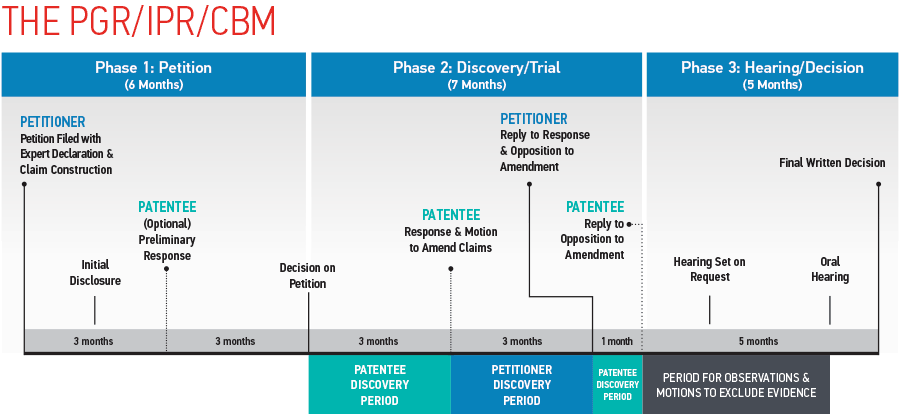

|

Post-grant review (PGR) was introduced by the America Invents Act (AIA) on September 16, 2012 as a counterpart to the inter partes review procedure.
Timing
First, timing is crucial. In order to file a PGR, the challenged claims of the patent must have an effective filing date of March 16, 2013 (pursuant to the “first inventor to file” rules) or later.
Additionally, a PGR can only be used to challenge a recently issued patent during a small window of time. A PGR petition must be filed within nine months after a patent’s issuance (or reissuance), otherwise IPR becomes the proper challenge vehicle. In addition, like IPR, a PGR petition must be filed before the petitioner seeks a declaratory judgment challenging the validity of the claims in federal court. In the below diagram of the timing interplay between available post-grant options, PGRs can only be filed within a short and discrete time frame.

Second, post-grant review enjoys more available statutory grounds for challenges, in addition to a broader scope of applicable prior art. As opposed to IPR where the grounds for a challenge are limited to anticipation and obviousness, post-grant review can be sought based on any grounds that can be used to challenge the validity of a patent claim. Such grounds include anticipation (§ 102), obviousness (§ 103), patent eligibility (§ 101) and lack of compliance with written description, enablement or indefiniteness (with the exception of best mode) (§ 112). In addition, PGR prior art is not limited to patents and printed publications. Indeed, post-grant review can be sought by alleging unpatentability based on evidence of public use, on-sale activity or other public disclosures.
Limited Discovery and Estoppel
Third, discovery is broader than allowed under inter partes review, and it is limited to evidence directly related to facts asserted by either party.
Finally, estoppel can be a significant barrier to success using post-grant review because of its broad and potentially severe limitations. Estoppel can be applied to any issue previously raised or that reasonably could have been raised in proceedings before the USPTO, federal district courts or the International Trade Commission (ITC).
Post-Grant Review Timeline
Like IPRs, PGRs also follow the same trial-like proceedings conducted in front of a panel of administrative judges at the USPTO. As shown below, the PGR process is broken down into the following three phases, including petition, discovery and hearing.
Petition
Post-grant review is requested by filing a petition at the USPTO. A petition must meet certain requirements. These include all of the following:
- Identifying the real parties in interest.
- Identifying the claims being challenged along with explanations of grounds of unpatentability for those claims.
- Providing a detailed explanation of the relevance of the evidence.
- Paying a filing fee.
The petition may also include technical declarations with evidence and opinions supporting the petitioner’s arguments. Importantly, this petition must be filed within nine months of the patent’s issuance.
Once a petition is filed, the patent owner has three months to submit a preliminary response. This response is optional, and the patent owner must weigh the positive and negative implications of this early filing option. At the very least, the preliminary response provides the patent owner with a chance to persuade the PTAB not to institute the PGR. Importantly, the patent owner is not allowed to submit evidence or rebuttal declarations directed to the validity challenges at this stage.
Within six months from filing, the PTAB reviews the petition and patent owner’s preliminary response (if any) and institutes a trial if it determines that there is a reasonable likelihood that the petitioner would prevail with respect to at least one of the claims challenged in the petition. In its institution decision, the PTAB may narrow issues, provide initial claim constructions and provide details regarding the grounds of unpatentability that will be at issue in the proceeding.
Discovery and Hearing Phases
Upon institution, the PTAB issues a scheduling order that concludes the proceeding within 12 months. Pursuant to the scheduling order, a patent owner is granted approximately three months to take discovery of the petitioner’s supporting evidence and to file a formal response or motion to amend. The scope of document discovery is still evolving. However, depositions of declarants and, at times, other witnesses is allowed.
The petitioner is then granted a three-month period to perform discovery on the patent owner’s supporting evidence and to file a reply brief or present arguments needed to counter a proposed amendment. A short period for motions may be provided before the oral hearing. After the oral hearing, the PTAB issues a final written decision regarding the patentability of the challenged claims. Parties involved in corresponding litigation may settle during the proceedings unless the PTAB has already decided the dispute on the merits. Both the patent owner and petitioner may appeal the PTAB’s final decision to the U.S. Court of Appeals for the Federal Circuit.
Below is a typical timeline for PGR proceedings:

Post-grant review (PGR) was introduced by the America Invents Act (AIA) on September 16, 2012 as a counterpart to the inter partes review procedure.
Timing
First, timing is crucial. In order to file a PGR, the challenged claims of the patent must have an effective filing date of March 16, 2013 (pursuant to the “first inventor to file” rules) or later.
Additionally, a PGR can only be used to challenge a recently issued patent during a small window of time. A PGR petition must be filed within nine months after a patent’s issuance (or reissuance), otherwise IPR becomes the proper challenge vehicle. In addition, like IPR, a PGR petition must be filed before the petitioner seeks a declaratory judgment challenging the validity of the claims in federal court. In the below diagram of the timing interplay between available post-grant options, PGRs can only be filed within a short and discrete time frame.

Second, post-grant review enjoys more available statutory grounds for challenges, in addition to a broader scope of applicable prior art. As opposed to IPR where the grounds for a challenge are limited to anticipation and obviousness, post-grant review can be sought based on any grounds that can be used to challenge the validity of a patent claim. Such grounds include anticipation (§ 102), obviousness (§ 103), patent eligibility (§ 101) and lack of compliance with written description, enablement or indefiniteness (with the exception of best mode) (§ 112). In addition, PGR prior art is not limited to patents and printed publications. Indeed, post-grant review can be sought by alleging unpatentability based on evidence of public use, on-sale activity or other public disclosures.
Limited Discovery and Estoppel
Third, discovery is broader than allowed under inter partes review, and it is limited to evidence directly related to facts asserted by either party.
Finally, estoppel can be a significant barrier to success using post-grant review because of its broad and potentially severe limitations. Estoppel can be applied to any issue previously raised or that reasonably could have been raised in proceedings before the USPTO, federal district courts or the International Trade Commission (ITC).
Post-Grant Review Timeline
Like IPRs, PGRs also follow the same trial-like proceedings conducted in front of a panel of administrative judges at the USPTO. As shown below, the PGR process is broken down into the following three phases, including petition, discovery and hearing.
Petition
Post-grant review is requested by filing a petition at the USPTO. A petition must meet certain requirements. These include all of the following:
- Identifying the real parties in interest.
- Identifying the claims being challenged along with explanations of grounds of unpatentability for those claims.
- Providing a detailed explanation of the relevance of the evidence.
- Paying a filing fee.
The petition may also include technical declarations with evidence and opinions supporting the petitioner’s arguments. Importantly, this petition must be filed within nine months of the patent’s issuance.
Once a petition is filed, the patent owner has three months to submit a preliminary response. This response is optional, and the patent owner must weigh the positive and negative implications of this early filing option. At the very least, the preliminary response provides the patent owner with a chance to persuade the PTAB not to institute the PGR. Importantly, the patent owner is not allowed to submit evidence or rebuttal declarations directed to the validity challenges at this stage.
Within six months from filing, the PTAB reviews the petition and patent owner’s preliminary response (if any) and institutes a trial if it determines that there is a reasonable likelihood that the petitioner would prevail with respect to at least one of the claims challenged in the petition. In its institution decision, the PTAB may narrow issues, provide initial claim constructions and provide details regarding the grounds of unpatentability that will be at issue in the proceeding.
Discovery and Hearing Phases
Upon institution, the PTAB issues a scheduling order that concludes the proceeding within 12 months. Pursuant to the scheduling order, a patent owner is granted approximately three months to take discovery of the petitioner’s supporting evidence and to file a formal response or motion to amend. The scope of document discovery is still evolving. However, depositions of declarants and, at times, other witnesses is allowed.
The petitioner is then granted a three-month period to perform discovery on the patent owner’s supporting evidence and to file a reply brief or present arguments needed to counter a proposed amendment. A short period for motions may be provided before the oral hearing. After the oral hearing, the PTAB issues a final written decision regarding the patentability of the challenged claims. Parties involved in corresponding litigation may settle during the proceedings unless the PTAB has already decided the dispute on the merits. Both the patent owner and petitioner may appeal the PTAB’s final decision to the U.S. Court of Appeals for the Federal Circuit.
Below is a typical timeline for PGR proceedings:


Post Issuance Procedure Matrix
Perkins Coie’s post-issuance procedure matrix is a comprehensive overview of key factors to consider when evaluating which post-grant procedure is the best fit for your matter.








